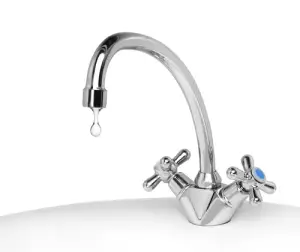A leaky faucet’s constant dripping is not only annoying—it’s a waste of a precious resource. According to a United States Geological Survey (USGS) drip calculator, a leaky faucet that drips 30 times per minute can waste nearly three gallons of water per day. That’s almost 90 gallons a month and more than 1,000 gallons per year.
So, whether it’s your kitchen or bathroom faucet that’s leaking, we offer these easy-to-follow tips on fixing your leaky tap. In this article, we’re strictly addressing leaky faucets dripping from the spout area. Check out our other article if your faucet is leaking at the base.
What Causes a Faucet to Drip?
There are many reasons your faucet could be leaking, more than you may realize. Here are some common causes:
- A worn-out or broken washer: This is one of the most typical sources of a leaking faucet. Over time the friction from turning on and off your faucets can cause them to break or wear out. In addition, leaking can also happen if the washer is not installed correctly or is the wrong size.
- A damaged cartridge: If your faucet has separate hot and cold handles, you likely have a cartridge-style faucet. A cartridge on each handle controls the water flow into the faucet spout. If your spigot is dripping, your cartridge will probably need to be replaced.
- A malfunctioning O-ring: An O-ring is a small disc affixed to the stem screw that holds the faucet handle in place. O-rings can wear out or loosen, similar to washers causing your faucet to leak.
- Water pressure: If your faucet spout only leaks when the faucet handles are moved a certain way or only once in a while, your home’s water pressure could be to blame.
- Deteriorated valve seat: The valve seat could be blamed if your faucet is leaking from the spout. Your tap is connected to the fixture by the valve seat. A leak can happen if sediment and corrosion build up on these parts.
These common leaky faucet sources can be detected and easily fixed with many faucet repair kits.
Repairing a Leaky Faucet
First off, if you’re comfortable taking apart a faucet and putting it back together with new parts, this is a good project for you. However, call an experienced plumber to fix your leaky tap if you’re not the do-it-yourself type.
To stop the dripping until the plumber can get there, locate the faucet valve under the sink to turn off the water supply. If you attempt to fix a leaky faucet yourself, you will need to figure out what type of faucet you are dealing with.
Primary Faucet Types
There are four main kinds of faucets:
- Compression
- Cartridge
- Ceramic disk
- Ball
You may not know the type of faucet you have until you take it apart. However, you may also be able to find out by searching for your faucet’s make and model.
Many manufacturers have diagrams and troubleshooting tips on their websites specifically tailored to their faucets. Many sites also have a series of questions to answer if you don’t know the make and model.
Tools You Will Need to Fix a Leaky Faucet
Gather an old towel to mop up drips plus the following tools:
- An Allen wrench
- Screwdrivers (both flathead and Phillips)
- An adjustable or crescent wrench
- Needle nose pliers
Before starting the repair job, shut off the water supply valves under your sink. Next, place a stopper or rag in the sink drain so that you don’t lose small parts down the drain.
Finally, place a paper towel on the counter to lay parts on it as you take the faucet apart.
How to Fix a Compression Faucet
As we mentioned above, one of the most common causes of a dripping faucet is a worn-out or broken washer. The washer is pushed against the valve seat every time you use your tap. This repeated friction can cause the washer to wear out and is common with compression faucets.
You can quickly fix a leak caused by these rubber gaskets by replacing the washer.
Compression faucets have two handles — one for hot and one for cold. Here are the steps to replace washers in these faucets:
- Turn off the water supply to your faucet using a valve beneath the sink.
- Use your Phillip’s or flathead screwdriver to remove the handles and the nut.
- Underneath, you’ll see the stem, which sits on the O-ring, which sits on the rubber washer.
- Remove the stem.
- Remove the washer, which is held in place by an upside-down brass screw.
- Replace the washer. Unless you already know the part number and size of the washer, you may need to pause here to run to the hardware store. Take the used washers with you to match the part.
- Reassemble the stem and faucet handles.
- Turn on the water valve and then the faucet.
- Check for leaks. If you notice dripping, start over or call a plumber.
Fixing a Single-Handle Ball Faucet
Repairing a single-handle ball faucet leak is a relatively straightforward DIY project.
- Shut off the water to your faucet.
- Open your faucet handles and let the remaining water empty into your sink.
- Remove the handle cap and set screw.
- Check and adjust the ring. You can use needle-nose pliers to take off the adjusting ring if necessary.
- Remove the plastic cam, the rubber packing washer, and the metal ball. Note the position the ball was in before removing it.
- Replace the springs and valve seats.
- Reassemble your ball assembly and then the rest of the faucet.
- Turn on the water valve and the faucet.
- Run hot and cold water and check for leaks.
Steps to Fix a Cartridge Faucet
Many household faucets today use a cartridge, a plastic piece that controls your faucet’s flow. Unfortunately, these faucets often leak due to worn O-rings, seats, springs, or cartridges.
- Shut off the water supply.
- Remove the faucet handles using your Allen wrench on the set screw.
- Remove the retaining nut.
- Pull out the cartridge using pliers.
- If water is dripping from your spout, put in new springs and seats.
- If the fixture is still leaking, replace the cartridge as well.
- Align the cartridge with the notches.
- Replace the large retaining nut and tighten it with a wrench.
- Put the handles back on.
- Check for leaks.
How to Fix a Ceramic Disc Type Faucet
Ceramic disc-type faucets are long-lasting but must be repaired if they develop water flow issues or leaks.
- Turn off the water at the water valve and drain water out of your pipes.
- Use your Allen wrench to remove the set screw.
- Take off the handle cover and decorative cap.
- Remove the retaining nut.
- Pull out the cartridge and pry out the seals with your flathead screwdriver.
- Clean the seals and seat area with an old toothbrush or replace them if necessary.
- Remove the O-ring and replace it if necessary.
- Replace the cartridge cylinder.
- Reassemble the faucet.
- Turn the water back on.
- Check for leaks.
If you get stuck, or it all seems just a bit too complicated, call a local plumber to handle the job. You may also want to consider signing up for a plumbing maintenance plan, which can help fix plumbing problems when they’re still minor issues.
Call Plumbing by Jake for Faucet Repair, Faucet Installation, and More
Contact Plumbing by Jake for faucet repair, installation, and all your plumbing needs. Are you looking for an emergency plumber? No problem. We’re available 24/7 to handle any plumbing emergency.
We serve both residential and commercial clients in Kingman, Bullhead City, Golden Valley, Lake Havasu, and surrounding areas of Arizona.

